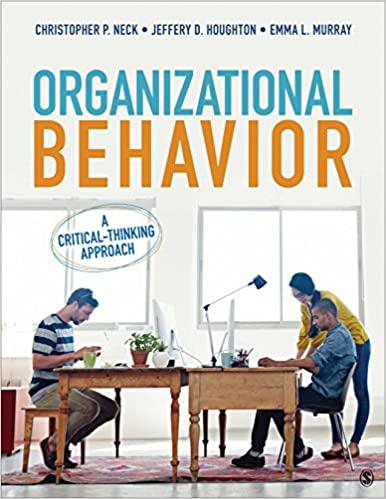Welcome to the millennial-centered workplace. At Euro-RSCG, a public relations firm, about 80 millennials (members of the
Question:
Welcome to the millennial-centered workplace. At Euro-RSCG, a public relations firm, about 80 millennials (members of the generation born in the 1980s and 1990s) can be found wearing flip-flops, displaying tattoos, indulging in a rooftop happy hour, and using Facebook during work hours. The firm provides time off for volunteer work, and employees leave early on Fridays during the summer. Google offers a free juice bar, a yoga and Pilates room, and even reimbursement for a personal trainer. Chesapeake Energy boasts a 72,000-square-foot on-site gym for employees and encourages employees to partake in smoking cessation programs.
Millennials, or generation Y, are a demanding bunch. “I have a girlfriend. I have family. I have friends. And these are all things that are very important, because we work to live and not the other way around,” said Greg Housset, a millennial employee of Euro-RSCG. In the age of social media, millennials are hyperconnected, have little patience for traditional hierarchy, and expect to find opportunities to connect in the workplace. According to MTV’s “No Collar Workers” survey, 80 percent of millennials want regular feedback from their managers, and 75 percent said what they really want are mentors. Millennials tend to be motivated to work in a job that is meaningful, not just lucrative—where their ideas count and they can put their creativity to work.
In the same study, a total of 81 percent of surveyed millennials think they should have flexible work hours and make their own schedules; 70 percent said that they needed to have personal time off while on the job; and 79 percent thought they should be allowed to wear jeans to work. Many would like the option to work in the convenience of their homes, using technologies like Skype to telecommute when needed.
It can be trying for baby boomers (who are often the signers of millennials’ paychecks) to entertain some of this generation’s philosophies about the workplace. Especially during a time when unemployment and underemployment is high for teens and 20-somethings, a prevailing reaction among older employers seems to be, “Beggars can’t be choosers, right?” But like it or not, millennials are, in fact, the future. There are about 80 million millennials and 76 million baby boomers in the United States today. About half of those millennials are already in the workplace, and millions more follow each year. By 2025, three of every four workers will be millennials.
“They’re the new marketplace,” said Marian Salzman, CEO of Euro-RSCG, who began her career in the 1980s.
But she knows she must adapt her company culture to the new kids in town in order to thrive. “[Millennials] are the new brains. They come with all the new social media tools and tricks already embedded in them as natives.”
She later added, speaking to her fellow baby boomers, “You’re not the smartest person in the room anymore. You may be the most experienced. You may be the wisest. You’re not the smartest.”
Salzman is learning to employ generation Y’s strengths to benefit the firm. She accomplishes this by listening to, and in many cases accommodating, their wishes. Other employers are now being advised on how to better manage millennials in the workplace. A few key tips for those managing the new generation: facilitate mentoring to allow for more cross-generational interaction, offer different working options like telecommuting or working off-site, and accommodate different learning styles. Keep employees engaged with educational and training opportunities and create recognition programs. Accommodate personal employee needs, and don’t confuse generational traits with character flaws.
Questions 1. Discuss how millennials have been both and external and internal force of change for organizations.
2. Discuss structural changes and how organizations having to make these to better suit millennials.
3. Recognize why baby boomers may be resistant to all of these changes being made in the modern workplace.
Step by Step Answer:

Organizational Behavior A Critical Thinking Approach
ISBN: 9781506314402
1st Edition
Authors: Christopher P. Neck, Jeffery D. Houghton, Emma L. Murray





